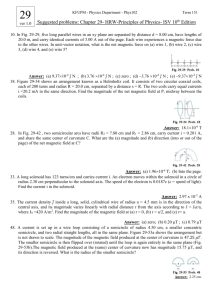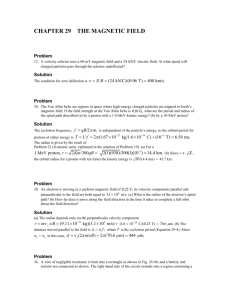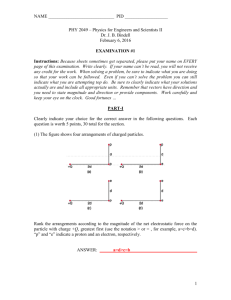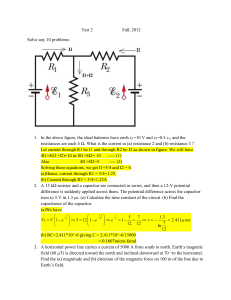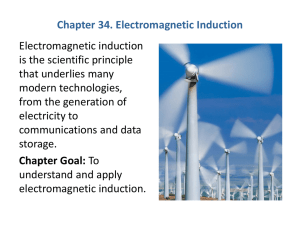PHYS 1401 Test 1 (1-4) Spring 2010 Name
advertisement
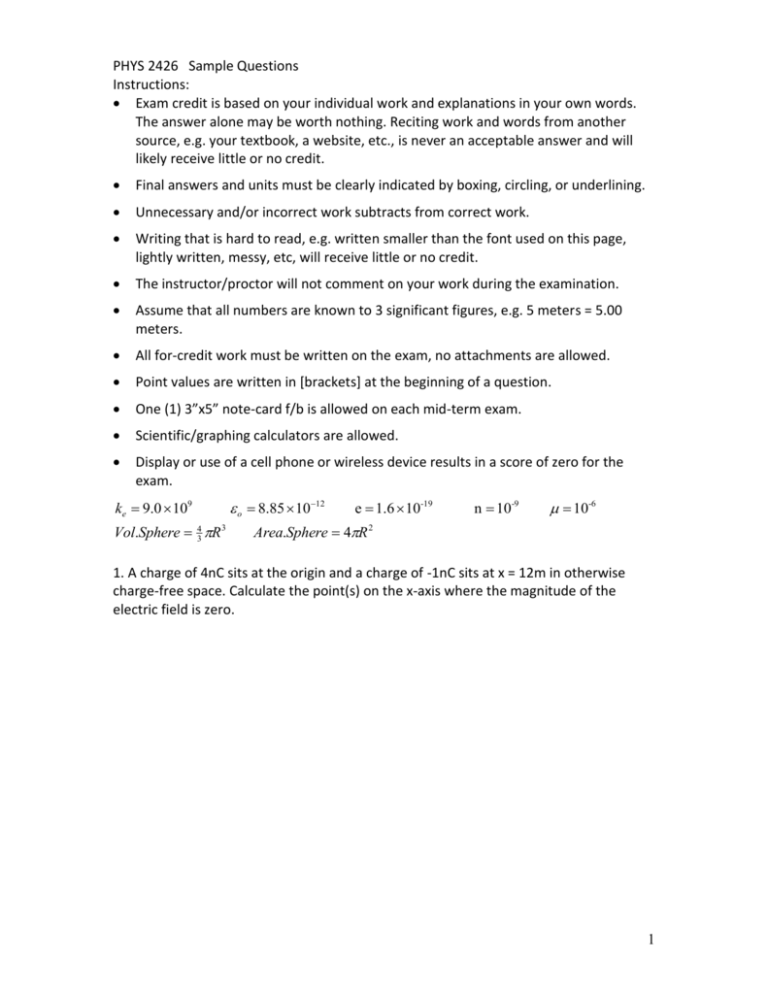
PHYS 2426 Sample Questions Instructions: Exam credit is based on your individual work and explanations in your own words. The answer alone may be worth nothing. Reciting work and words from another source, e.g. your textbook, a website, etc., is never an acceptable answer and will likely receive little or no credit. Final answers and units must be clearly indicated by boxing, circling, or underlining. Unnecessary and/or incorrect work subtracts from correct work. Writing that is hard to read, e.g. written smaller than the font used on this page, lightly written, messy, etc, will receive little or no credit. The instructor/proctor will not comment on your work during the examination. Assume that all numbers are known to 3 significant figures, e.g. 5 meters = 5.00 meters. All for-credit work must be written on the exam, no attachments are allowed. Point values are written in [brackets] at the beginning of a question. One (1) 3”x5” note-card f/b is allowed on each mid-term exam. Scientific/graphing calculators are allowed. Display or use of a cell phone or wireless device results in a score of zero for the exam. ke 9.0 109 Vol.Sphere 43 R 3 o 8.85 1012 e 1.6 10-19 n 10-9 10-6 Area.Sphere 4R 2 1. A charge of 4nC sits at the origin and a charge of -1nC sits at x = 12m in otherwise charge-free space. Calculate the point(s) on the x-axis where the magnitude of the electric field is zero. 1 2. [1] How many electrons must be removed from a neutral object in order for the object to obtain a net charge of 1nC? 3. A charge of +1nC is on the y-axis at y = +3m and a charge of -1nC is on the y-axis at y = -3m in otherwise charge-free space. a) [2] Calculate the magnitude of the electric field on the x-axis at x = 1m. b) [1] Calculate the magnitude of the electric potential on the x-axis at x = 1m. 3. [1] The electric field at a point is non-zero and the voltage at this point is zero. An example of this condition… a) does not exist b) exists halfway between a charge +Q and a charge –Q. 4. [2] A solid sphere of radius R = 0.20m has a radial charge density distribution A ρ , where A 3nC/m 2 . Calculate the net-charge of the sphere. r 2 5. [1] A sphere of radius R = 0.10m has a uniform charge density distribution within it, and a net charge of +2nC. Calculate the magnitude of the electric field at a distance of 0.05m from the center of the sphere. 6. A very thin conducting square plate has sides that are 5m long and has a net charge of +4nC. The plate lies in the x = 0 plane with its center at the origin. a) [1] What is the direction of the electric field at x = 0.05m ___ iˆ ___ iˆ ___ ĵ ___ ĵ ___ k̂ ___ k̂ b) [1] Use Gauss’s Law to calculate the magnitude of the electric field at x = 0.001m on the x-axis. 7. A ring of radius 1m is in the x = 0 plane and has its center at the origin. The ring has a uniform charge of +12nC. a) [2] Calculate the magnitude of the electric field on the x-axis at x = 1m. b) [1] Calculate the magnitude of the electric potential on the x-axis at x = 1m. 3 8. The electric potential along the x-axis is given by V(x) = 3 + 4x – 6x2, where V is in volts and x is in meters. Calculate the general vector function E(x). 9. For the capacitor network shown below. a) [1] Calculate the equivalent capacitance of the network. b) [1] A 6.0 volt battery is connected to the network and the capacitors are allowed to become fully charged. Calculate the voltage across the 6.0 microfarad capacitor in this state. 4 10. [1] A square has equal positive charges at three of its corners, as shown. Which arrow shows the correct direction of the electric field at point P? ____ Explain for credit. 11. [1] A horizontal surface of area 0.321 m2 has an electric flux of 123 N.m2/C passing through it at an angle of 25° to the horizontal. If the flux is due to a uniform electric field, calculate the magnitude of the electric field. 1. [1] What are the SI units of ampere·hours? _________________ 2. [1] A 1.5 volt battery is rated as 2500 milliampere·hours. Calculate the joules of energy is stored in the (new) battery. 4. [1] A wire made of a pure substance has length L, cross-sectional area A. The wire is now pulled so that it is thinner and its length is 1.5L. Is the resistance of the wire increased or decreased? ______ By what factor is the resistance changed? __________ Show work for credit. 5 6. All questions for this problem refer to the diagram below. a) [1] Write the Kirchoff Current Rule for the currents as they are labeled on the diagram: ________________________________________ b) [1] What is the change in voltage if you move from point a to point d in terms of the 4V battery, the 3 ohm resistor, and the current I2? ________________________________________ c) [2] Calculate the value of I3 in ampere. I3=________ 7. [1] A battery has a terminal voltage of 12.2 volts when not being used. The internal resistance of the battery is 0.05 ohms. Calculate the terminal voltage of the battery when the current in the battery is 10.0 amperes. 9. [1] A positive charge is moving due North in a region where the net magnetic field is directly upwards. What is the direction of the magnetic force on the charge? (circle one): up down East West North South. 6 11. [1] A positive current I flows as shown in the wire segment below. What is the direction of the magnetic field at point P in the diagram below due to this wire segment? ______________ Explain for credit. 8 1 P 3 4 7 6 2 5 I 12. [1] A 500 turn coil has a cross-sectional area of 0.15 square meters. A current of 8 amperes flows in the coil. Calculate the maximum torque exerted on the coil if it is in a uniform magnetic field of 0.25 tesla. 13. [1] Calculate the magnitude of the magnetic field at a point 0.50m directly above the midpoint of a 1.0m long horizontal current segment carrying 8 amperes of electrical current. For credit, show work and box answer. 14. [1] A solenoid is 0.10m long and has cross-sectional area of 1 square centimeter. When the current in the solenoid is 25 amperes the magnetic field at the center of the solenoid is 0.5 tesla. Calculate the number of turns of wire on the solenoid. 7 15. The north pole of a magnet is being removed from the center of a solid donutshaped ring of conducting wire (shown in cross section below). From the point of view of the magnet, what is the direction of the current induced in the ring? _______________________ Explain. 16. [1] Positive current I is flowing into the metallic strip shown below. Which face of the strip will negative charges accumulate? Explain for credit. a) surface 1 b) surface 2 c) surface 3 d) the face opposite surface 1 e) the face opposite surface 2 19. [1] The flux through a coil varies with time as m 400t 200 , where m is in webers and t is in seconds. Calculate the emf induced in the coil in volts. 8
